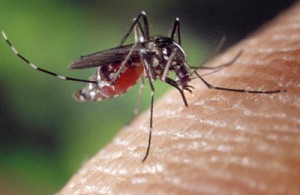Mosquitos: They are the scourge of summer activities—the annoying buzzing noise as they fly around our ears and the pain, itching and swelling associated with their bites. Worst of all, certain species of mosquitoes can transmit diseases such as West Nile virus, Dengue fever and malaria. Defense mechanisms such as mosquito repellent, covering my head with netting and wearing heavy clothing are often insufficient against the swarm of hungry insects. It’s enough to make me want to stay indoors.
Those people who cannot escape these pests have a higher risk of being bitten and contracting a disease such as malaria, which killed an estimated 627,000 people in 2012, mostly in Africa and southeast Asia (1). A common step in malaria reduction programs in high-risk areas is reducing the number of Anopheles gambiae mosquitoes, which act as the host for malaria-causing parasites. This often involves massive amounts of insecticides, including limited amounts of the much maligned but very effective insecticide dichlorodiphenyltrichloroethane (DDT). Due to these programs, the World Health Organization (WHO) estimates that between 2000 and 2012, malaria mortality rates decreased by 42% worldwide, including a 48% decrease in children under 5 years of age. Clearly these programs are saving lives, but wouldn’t it be nice to achieve the same thing with fewer pesticides?
In this report in Nature Communications (2), Roberto Galizi and his colleagues took a clever approach to controlling mosquito populations: Genetic modification of mosquitoes to distort the gender ratio and reduce the number of female mosquitoes. Fewer females means fewer mosquitoes to transmit disease (because only female mosquitoes bite) and to produce the next generation.
In the 1960s and 70s, scientists described naturally occurring mosquito strains of sex ratio distorters, which produce a lower percentage of female progeny through disruption of the X chromosome during male meiosis (3,4). However, the sex ratio distortion was too low to effectively suppress mosquito populations, and the females of these strains quickly developed resistance. Rather than relying on natural mechanisms to cleave the X chromosome, Galizi et al. decided to engineer a synthetic sex distortion system using I-PpoI, a dimeric endonuclease that cuts specifically within Anopheles gambiae ribosomal gene sequences (rDNA), which are located in a single cluster on the X chromosome. They would create a transgenic strain of Anopheles that expresses I-PpoI in sperm cells to cleave the X chromosome and produce mostly Y chromosome-bearing sperm and thus male progeny. These male progeny would inherit the I-PpoI endonuclease gene, resulting in subsequent generations of mostly male mosquitoes.
For this approach to work, the scientists must maintain viability and fertility of the male mosquitoes. Since systemic I-PpoI expression would be fatal, they created a transgenic mosquito that expressed I-PpoI under the control of the spermatogenesis-specific β2 tubulin promoter so that the paternal X chromosome was cleaved only in X-bearing sperm. Viability problem solved. There was another problem though: Wildtype I-PpoI protein was so stable and persistent that the maternal X chromosome in the zygote was cleaved post-fertilization, leading to death. Male mosquitoes expressing wildtype I-PpoI were infertile.
The researchers quickly devised a solution: Destabilize I-PpoI so that endonuclease activity does not carry over into the zygote. They performed site-directed mutagenesis of 11 amino acid residues involved in coordination of structural zinc ions, protein folding or subunit interaction, then tested these mutations for decreased thermostability and specific activity. They also created germline transformants that expressed each of these I-PpoI mutations. They identified three strains that produced 95.0–97.4% male offspring and had fertility rates that did not differ significantly from the controls. These transgenic mosquitoes passed the destabilized I-PpoI endonuclease on to their male offspring.
When transgenic mosquitoes carrying one of the more promising mutations (L111A) were introduced into a breeding population, the result was a dramatic reduction in the number of female mosquitoes. Introducing 150 male transgenic mosquitoes and 50 wildtype male mosquitoes into each cage of 50 wildtype female mosquitoes resulted in a complete elimination of mosquitoes within six generations in 4 of the 5 cages. In their population models, this 3:1 ratio of transgenic:wildtype mosquitoes was much more effective than other approaches to suppressing mosquito populations such as introducing sterile males or males carrying a female-specific late-acting dominant lethal mutation.
One of the beautiful things about the approach taken by Galizi et al. is that the risk of mosquitoes rapidly developing a resistance to this sex ratio distortion is low. The I-PpoI target sequences within the multicopy essential 28S rDNA genes are universally conserved, making it unlikely that changes to this sequence to evade cleavage by I-PpoI would be tolerated.
What does this mean for the Anopheles gambiae population of the world? Well, at least in the near future: Nothing. There is no risk of a mosquito shortage any time soon. This work has not been tested in wild populations, and these transgenic mosquitoes have been produced only on a small scale. However, all data generated so far suggest that this lab’s work is a tremendous starting point to help control a disease that claims hundreds of thousands of lives each year.
References
- World Malaria Report 2013, World Health Organization
- Galizi, R. et al. (2014) A synthetic sex ratio distortion system for the control of the human malaria mosquito. Nature Communications doi:10.1038/ncomms4977
- Hickey, W.A. and Craig, G.B. Jr (1966) Genetic distortion of sex ratio in a mosquito, Aedes aegypti. Genetics 53, 1177–96.
- Sweeny, T.L. and Barr, A.R. (1978) Sex ratio distortion caused by meiotic drive in a mosquito, Culex pipiens L. Genetics 88, 427–46.

